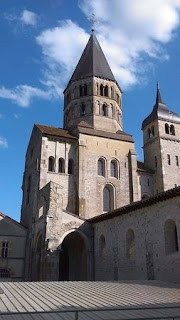The class made it up through Charlemagne and the year 800, but we skip forward a couple hundred years, and arrive in the 11th century. In those two hundred years, society was organized enough for people to settle down, build cities, trade was on the rise once again, and merchants were plentiful. We wrapped up the first week with a tiny blurb about pilgrimage, and that's where the second lesson picks up. Pilgrimage, as we discussed before, was one way medieval Christians could prove their devotion to God. A pilgrimage was a physical representation of a person's search for spiritual guidance and their walk with Christ. They traveled to holy places (called shrines) where saints were buried or sacred objects were kept in order to seek penance for sins, healing, and the cleansing of the soul of the world.
Pilgrimage was big business. Along a pilgrim's journey, they needed food, accommodation, clothing, and souvenirs/badges (like people would collect on walking staffs or a more modern reference would be collectible spoons from places visited). Pilgrims carried their money on their person as there were no banks, making them susceptible to thieves. The need to protect the pilgrims along their journey gave rise to the Knights Templar, whose initial job was to police the pilgrim routes and keep them safe on their sacred journeys.
The two main destinations, of course, were Rome or Jerusalem (the Holy Land). But not everyone could afford to go so far or were not well enough in health to make the long journey. There is a map of the routes and an article covering the Cult of the Relic from Khan Academy that is fantastic. The routes were dotted with shrines, monasteries and churches to aid the pilgrim along their way.
In recent years, the British Museum housed an exhibit on relics and reliquary. These Treasures of Heaven were believed by monks and other clergy to help guide people in their knowledge and love of God. The most important relics were directly related to Christ. One of these relics is a thorn from the crown that Jesus wore. Relics were placed in reliquary. This container, as the decades passed became more ornate. This example of reliquary is from a later period than we are studying, but it shows the craftsmanship and the detail given in honor of the relic it holds.
At the monastery at Cluny, the monks did very little work, spending their time in the church, writing, singing, and performing services. These monks, led by Abbot Hugh, came mostly from noble families and were accustomed to the finer things in life. The Cluniac monks believed the arts and finest materials should be used to create a space to worship and glorify God. This emphasis on providing deeper devotion to God and encouraging pilgrimage was called Cluniac Reform.
The church building at Cluny was constructed in the Romanesque architectural style, which predates the Gothic architectural style. Work began in 1088 and continued until 1157. It may not make sense to some to go back so far before learning the Gothic architectural style, but in the coming weeks, we will see that most churches/cathedrals are built in layers. There are areas of a cathedral that will be Romanesque, or Gothic, or even the later Renaissance. The hope is to spot the differences.
Cluny Abbey set the pattern and the tone for future large scale buildings, and this link gives more information on the monks and the architecture of the Abbey. However, not all were on board with this break from a solitary, frippery-less lifestyle, for St. Bernard of Clairveaux, of a nearby monastery and a contemporary of Abbot Hugh, was not impressed with the new church building at Cluny. He declared "Oh, vanity of vanities- and foolish, too. The walls are splendid, but the poor are not there."
Now that we have the first large scale building, how do we get to a cathedral? The Christian world during the medieval period was divided into regions called 'sees' or 'diocese' for the purposes of Church government and administration. The church hierarchy from least to greatest is friar, novice, nun, abbess, monk, deacon, priest, bishop, and archbishop. Each diocese was ruled by a bishop. These bishops usually came from noble families and wealth. A cathedral was the headquarters for the bishop, coming from the Greek word 'cathedra' for throne. The bishop chose the location for a cathedral, and based his decision on the large towns or cities in his diocese, if the site had been the location of an earlier church, and particularly if the site contained holy relics or had been founded by a saint.
In terms of the pilgrimage, traveling to a location that was a large town with everything they needed in one place was huge. Their physical and spiritual needs were being met. Durham Cathedral is a prime example of Romanesque architectural style, having been founded by a saint and holding the relics of St. Cuthbert of Lindisfarne, having strategic location, and previous building structures in the Anglo-Saxon style. In England, Romanesque architecture is known as Norman or Norman Romanesque.
Romanesque architecture is heavier, as can be seen in the Durham Cathedral link above, and the light is low. The comparisons between Romanesque and Gothic architecture will continue in the next lesson.





No comments:
Post a Comment